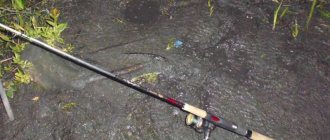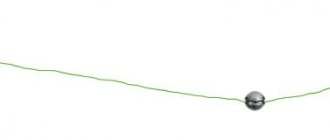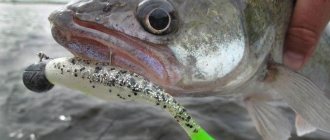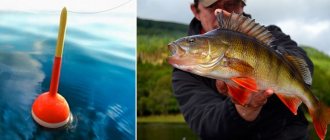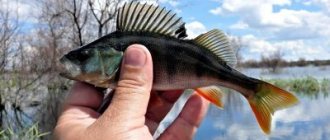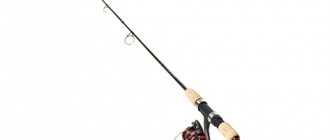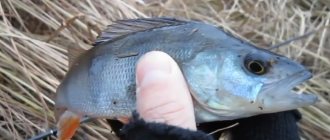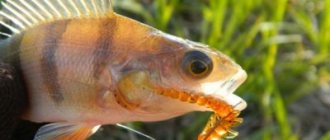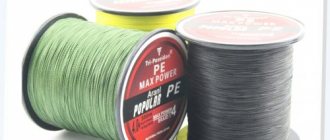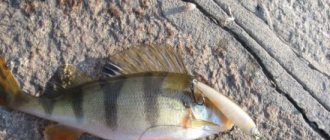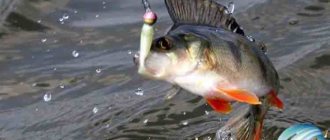Optimal spinning rod for perch
Beginner fishermen want to get the optimal spinning rod for catching striped predators. A universal whip for a beginner with technical indicators is:
- The rod weighs up to 10 grams, no more.
- It is better to take ultralight, which can be used to feed bait weighing 2–15 grams.
- The upper dough limit is from 7 to 10 g.
- Fast or medium-fast action is suitable.
- The length of the stick is from 180 to 240 cm. It all depends on the chosen hunting location: shore or boat.
- As for the coil. It should be light, up to 0.2 kg. On the spool you need to place a fishing line with a diameter of up to 0.2 mm, or a cord of 0.1-0.12 mm. Therefore, the spool capacity according to the Shiman classification is 1–2 thousand.
We can say that this is the optimal spinning rod for perch. But there are a number of other nuances that we will reveal as the publication progresses. Possessing a spinning rod with the specified parameters, a novice minke whale hunter will not have much difficulty in catching his first trophy.
Choosing a spinning rod for perch fishing
The success of perch fishing depends on the choice of spinning rod, the choice of which, in turn, directly depends on the place where this striped predator is caught.
Fish of the perch family are found in all bodies of water - rivers and lakes; they are not artificially bred. Perch can be found anywhere in the water area of a reservoir, as this predator hunts all day, chasing fry both in depth and in shallow water. Typically, a school of perch thins out a school of fry surrounded by it, forming a cauldron. For this method of hunting, the perch received the nickname - the robber. This predatory fish hunts, as a rule, during the day, and sometimes in the evening, reminiscent of pike perch in this behavior.
The most comfortable place for striped bass is among snags - this is where you can catch the largest specimen; in other places small specimens weighing no more than half a kilogram are caught.
Spinning should be selected based on the fishing area and the weight of the intended catch in accordance with the class and range of application.
Light class spinning rods are used for medium and small sized lures such as wobblers, spoons and jigs.
For twitching, you need a rigid and short spinning rod with a Fast, ExtraFast position in order to accurately guide the bait.
The easiest and most delicate fishing with super light baits - micro-oscillators and micro-jigs - is carried out with Ultra Light class equipment.
The casting distance depends on the length of the spinning rod - 180-240 centimeters.
The length of the spinning rod depending on the depth of the reservoir for catching perch:
- shallow areas up to 2 m close to the shore - use a rod with a length of 1.6 m - 2.4 m (the weight of the bait can vary depending on the spinning test, the presence of a current in the reservoir and other weather conditions);
- depths of more than 2.5 m - use a rod with a bait test from 3.5 to 10 g;
- greater depths - a spinning rod with a test weight of 20 grams or more is required).
How to choose a spinning rod for perch according to parameters
When choosing a spinning rod, you need to take into account its parameters, which include:
- test;
- rod length;
- system;
- material of manufacture;
- whip design.
When choosing a rod for catching striped prankster, you need to know and remember that all spinning rods are conventionally divided into 3 classes with a certain test, such as:
- Light class poles. The test ranges from 2 to 15 grams.
- Middle class rods with test values from 10 to 30 g.
- Heavy artillery third class. The test starts from 30 grams and above.
Let's take a closer look at what a test is and how it affects fishing?
Build
Rod action is divided into slow, medium and fast. Slow ones are characterized by bending of the whip under load along the entire length, while fast ones are characterized by bending only at the tip.
Rods with a medium action bend to the middle of the whip. The sensitivity when playing and hooking fish depends on the action, and it also affects the casting distance of the selected bait.
Rods with slow and medium action will allow the fisherman to make long casts, have good flexibility and sensitivity when retrieving, and are able to absorb the jerks of the fish. For these reasons, such rods are excellent for catching perch.
Spinning test for perch and its effect on fishing
In the previous segment, we already told you what a spinning rod test for perch can be. Now let's find out its role when hunting for a predator. Individual specimens of perch can exceed 1 kg. But this is rather an exception to the rule. The majority of minke whales weigh 300–500 grams. Therefore, the spinning rod should be light or ultra-light class.
If you put a bait, say 25 grams, on a rod with a weight of 2–10 grams, you won’t be able to cast it far. In addition, the wiring will be ineffective. Playing bait will not attract a predator: hunting for perch will not bring the desired result.
Rod build
When choosing a fishing rod, you need to take into account its structure, in other words, flexibility.
- Fast build. Only the tip of this rod bends. The rod is very tough.
- Medium build. This rod can be bent to the middle of the blank.
- Slow build. The rod is soft and bends almost to the handle.
Each option has its positive and negative aspects. For example, fast-action sticks allow you to perform precise casting and at the same time have high sensitivity. Of the main disadvantages of fast action spinning rods, two points can be distinguished:
- Rod cushioning.
- Short bait casting range.
As for slow action rods, they deliver the bait over a long distance. And the shock absorption is good. Therefore, such spinning rods can be equipped with a thin fishing line without fear that a trophy specimen is sitting on the hook. But this rod has its skeletons in the closet, such as:
- Low sensitivity.
- Problem related to throwing accuracy.
Please note that we do not consider medium action rods in detail. They are, as it were, the golden mean. But this does not mean that you should buy medium-action rods.
Basic spinning parameters:
- Test
- Length
- Build
- Material
- Design
A test is a value that characterizes the permissible weight of baits used with a specific fishing rod. Action is the specific shape that a rod takes when loaded. Characterizes the level of sensitivity of the rod and its flexibility, potential casting range.
Design features are also important, namely the convenience of the handle and the material of manufacture, the location and features of the access rings. Since perch is usually caught using small baits, it is advisable to take a minimal spinning test.
Length
When choosing a spinning rod for a striped predator, you need to take into account the length, which directly depends on the method and place of fishing. For fishing from the coastal zone, you should take a long stick, taking into account the nature of the reservoir: bushes, trees hanging over the water, and the steepness of the shore. It is more convenient to fish from a boat with a short rod. The length of the spinning rod is affected by stiffness of movement and limited space.
Experts and athletes recommend using a stick, the length of which is between 2.4-3.2 meters, when fishing from the shore. But the choice of length, as already mentioned, depends on the coastal landscape.
When choosing a spinning rod for perch from a boat, you should give preference to a spinning rod with a length of 1.8-2.1 meters. It is believed that longer structures can be used in open water, although this does not happen so often.
In both cases, the spinner performs many casts. At the end of the rest, out of habit, my hands hurt and my back ache. Therefore, you need to think several times about which rod to take for fishing.
Coil
As mentioned earlier, the average size of a striped predator ranges from 300 to 500 grams. Consequently, a powerful and heavy coil will not justify itself; there is no point in installing it. It is advisable to use thin fishing line on a 1 thousand spool. It will hold 100 meters of fishing line with a diameter of 0.1 mm. This is quite enough for fishing from the shore or boat. The average casting length of a 10 gram bait is 30 meters.
"Pike" range
At least 90% of all perch spinning rods fit into the framework that we outlined above. But sometimes perch is caught with heavier gear. We are not talking here about when perch is caught as bycatch when catching more serious predators, but about those cases where it is the main target.
There are two such cases. The first is long-range lead rigs - “Otvodnik” or “Carolina” with a heavy sinker. Thanks to the bullet, weighing 25 - 30 g, a small silicone bait is delivered, roughly speaking, to the fairway, and from this “long distance” a medium-sized perch is caught. The model, of course, must correspond to the total weight of the equipment according to the test. The only wish: it would be better to have a softer tip - with it there is a greater chance of not missing a delicate perch bite on rough tackle in general.
The second case is when large perches en masse occupy typical pike habitats. This is observed from time to time in different parts of the Volga reservoirs. Then we catch them with pike tackle and lures - for example, we twitch wobblers up to 130 inclusive. Well, now we consider pike as bycatch.
fishing line
There are two options in this matter:
- Use fishing line.
- Or a braided one.
There is no consensus on this issue. Some prefer fishing line, others prefer cord. Many people tend to believe that a fishing line with a diameter of 0.18 mm is the best option. She copes with the obstinate minke whale and easily removes it from the water. A fishing line of this diameter combines with a spinning rod of medium or slow action: the shock absorption of the rod works.
As for the braided line. It has exactly the same breaking load as mono/filament. A cord with a diameter of 0.1-0.12 mm has the same strength as the monofilament version. Monofilament with a diameter of 0.25-0.30 mm, with a break of 2.5 kg, is also an option. Experienced fishermen prefer braided line, knowing that next to the perch there may be a toothy pike that can instantly bite through the fishing line.
What else to pay attention to
It is also important what material the spinning rod’s whip and handle are made of. You can safely take a rod made of fiberglass. In addition, their cost will not scare a beginner. The main thing is the form: what it is made of and what quality it is. In specialized stores there are products:
- Made from carbon.
- And composite materials.
They have decent quality characteristics. One catch is the price. Let's focus on the rod handle. It is made: From corrugated plastic. This is a budget option.
- Neoprene option.
- Cork version.
The choice of handle is the prerogative of the fisherman. It's nice to feel a good quality handle. Although, this is not important to the perch. A hungry predator does not pay attention to the flaws in the beginner’s wiring and attacks the bait.
Lures for catching perch using a spinning rod
- wobblers
- spinners
- oscillating spoon
- silicone baits
Selecting a spinning rod (video)
Also read our interesting articles on the topic of spinning:
- The best budget spinning rods
- Budget reels for spinning rods
- Budget reels for ultralight spinning rods
- Spinning equipment
- What materials are fishing rods made of?
- About offset hooks
- Floating silicone baits
- DIY silicone baits at home
- A selection of articles about spinning gear
Author of the article: Vitaly Leonidovich Ivanov, 2021.
Rating of spinning rods for perch
It would be surprising to ignore popular models of spinning rods.
Zebco Topic Tele Star
The telescope is made of composite material. The cost is reasonable. It’s good because it doesn’t take up much space if you’re traveling on foot to the fishing spot. Performance indicators 240 mm length. When folded, it is 64 cm. The weight of the stick is 186 grams. Test: 8-23 gr.
Maximus Legend-X 18UL
A powerful, sensitive universal rod with a fast action. It performs well when working with wobblers, small spinners and jig baits.
Kosadaka Lighting 210 UL
A rod of good quality, middle class, with good sensitivity. They can safely catch medium-sized perch on a jig.
Daiwa Morethan Branzino 87LML
Pay attention to the expensive plug, 261 cm long. Test 3-15 grams. The weight of the product is only 122 g.
Volzhanka
Among the domestic developments, we can highlight the tackle for catching perch: Volzhanka Lux 2-7. This is a mid-range spinning rod. Shows itself well in working with small-sized spinners. The difference is high sensitivity.
From light spinning rod and above | Length and sensitivity
You, of course, have noticed that almost all ultralight-class spinning rods are limited in length to seven to seven and a half feet. This is mainly because, purely technically, without negative side effects, it is much more difficult to perform a longer ultralight.
But with light this problem is much less relevant, not to mention ML class models. In coastal perch fishing on Big Water, the desired length of the spinning rod is 8 feet and above, and the top of the test is approximately 12 to 20 g. That is, the class is just L or ML. There are more than enough offers of spinning rods with such characteristics in stores. Therefore, in this segment the question of making the right choice arises.
The survey results confirm the idea that the main (and by a significant margin) type of bait in fishing with long coastal spinning rods is the jig. Therefore, jig-oriented models are most in demand. For example, the Maximus Dreamer-X 832ML, which I used to successfully catch backbone perch in the Basque Country a couple of years ago...
Most long shore spinning rods have a jig specialization
Often, when a discussion of the topic “perch - jig” begins, the question arises about the sensitivity of the spinning rod. After all, the perch bite is almost always weaker than the pike or zander jig bite. And you just may not feel it. Therefore, a more expensive and sensory rod is welcome in our case. However, its role should not be overestimated.
I remember that in the mid-00s, large perch, sometimes over a kilo, were regularly caught on the Moscow River. So, up to half of all catches occurred in cases where the perch landed on its own - without a noticeable bite and therefore without hooking.
You just start turning the reel handle after stopping the jig once again - and the perch is already sitting. And the fishing rod I had back then was the Talon Professional series - one of the most sensory at that time. What I mean is that there is still no particular reason to chase maximum sensitivity, paying a lot of money for the corresponding spinning rod. It’s more rational to choose a mid-level spinning rod with suitable characteristics.
For me, the main one for several years now has been Zertix Avalanche 852ML. What is worth noting here is that this model is not “radically jigging”, but with some jigging priority. That is, if necessary, you can twitch it and drive “turntables” with cranks. Twitching may be less ideal than with a shorter specialized model, but still more comfortable than with most other long spinning rods.
If fishing involves the use of a variety of types of bait - without an emphasis on any one of them (a typical situation for the summer Moscow River), then a full all-rounder is more appropriate - building a regular-fast one. For me it is often an old budget Mottomo Distancia 802L. It has no special pretensions to tactile sensitivity, but it is very catchy and, again, loyal to all types of baits.
